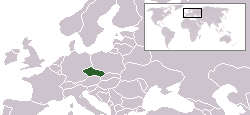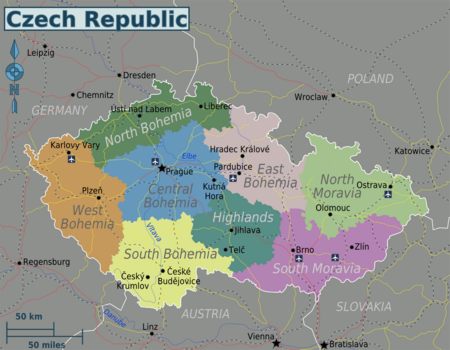 |
| capital | Prague |
| currency | Czech Crown (Kč)-"Koruna" |
| population | 10,235,455 (July 2006 est.) |
| Power Systems | 230V/50Hz (European plug) |
| country code | 420 |
| Time zone | UTC 1 (winter time) / UTC 2 (summer time) |
| Language | Czech(official), Slovak |
| Emergency call | 112, 150 (fire department), 155 (emergency medical service), 158 (police agency) |
| Driving direction | right |
|
Czech Republic(Czech:Česká republika;English:Czech Republic) Common nameCzech Republic(Česko),YesCentral EuropeOf a country.
learn
After the First World War, the closely related Czechoslovakia and the former Austro-Hungarian Empire merged to form a new country, Czechoslovakia. During the two world wars, new national leaders were often busy meeting the demands of ethnic minorities in other republics, especially Germany and Hungary in the Sudetenland. A bad relationship with the German minority (20% of the total population) is a specific problem that was capitalized on Hitler and used as a "justification" for the dismemberment of the nation before the outbreak of World War II. The country annexed and occupied Germany during the war. After the Second World War, Czechoslovakia expelled most of its German power, and many ethnic Hungarians followed the direction of the Potsdam Conference. However, the country is very fortunate that it escaped the war more or less intact, because it avoided the fate of large-scale aerial bombing and razed the history of the nearest neighboring cities in Germany, Austria, Poland and Belarus. The country belonged to the sphere of influence of the Soviet Union and used force until 1989. In 1968, the efforts of the invading troops of the Warsaw Pact ended the country’s leaders opening up to communist rule and establishing "socialism with a human touch." The anti-Soviet demonstrations ushered in a period of brutal suppression and conservatism in the party the following year. In November 1989, the deposed communist government was in a peaceful "velvet revolution." In January 1993, the country had a "velvet divorce" to its two national components, the Czech Republic and Slovakia. Now, NATO members (since 1999) and the European Union (since 2004), the Czech Republic is moving towards an integrated world market, and development brings both opportunities and risks. The Czech Republic is not a big country, but it has a rich history. Since ancient times, Czechs, Germans, Jews and Slovakia, as well as Italian masons and painters, merchants and deserters from Napoleon’s army in France have all lived and worked here, all influencing each other. For hundreds of years, they cultivated their land and created works together, which still make us respect and admire today. It is precisely because of their creativity and skills that this small country is surrounded by hundreds of ancient castles, monasteries and stately mansions, and even the entire city gives the impression that it is full of cultural relics. The Czech Republic features a huge amount of buildings to cherish and has beautiful forests and mountains to match. The Czech flag (see above) is the same previously used Czechoslovakia and was readopted in 1993.
living habit
- Easter (Velikonoce): On Easter Monday it is customary for guys (slightly) to slap girls and women with a wicker stick at the end (pomlázka) with colorful ribbons, in the hope that the girls and women will in turn give them colored eggs, candies or drinks. After noon, the girl defended herself by watering the guy. Obvious tourists are often (but not always) exempted.
- Burning the Witch (Paleni čarodějnic) or Witch’s Night (Čarodějnice): In the evening of April this year, bonfires were lit all over the country. The "witch" statue, as a symbol of evil, was raised and burned in the fire. This is a reinterpretation of the old pagan festival (Berna) by the Christian Inquisition. Since most Czechs might like witches too, investigators, in many fires no witches were burned, and the festival was celebrated in a more primitive pagan way-witches are those who should celebrate the night instead of being burned. It will not stop jokes like "Honey, you will hide or burn tonight!".
- The last ringtone (Persledni zvonění)It is a traditional celebration at the end of last year in a higher school. This is the celebration usually at the end of April or the beginning of May, a week or more before the final exam (maturita Czech) is held (time may vary in different schools). Students get a free day, usually doing stupid things, boring costumes. They go to the streets and collect money from people passing by, sometimes they threaten water and spray them with lipstick or perfume on their faces. The money collected is used by the party after the exam.
- Holy Feast Mikulas Zulin (Saint Nicholas, Santa Claus), December 5th: On this day, St. Mikura Shzulin wandering sister, angel and devil related to him. He gave small gifts and candies to children to reward them for their good behavior throughout the year, while the devil severely punished children for their crimes over a year of courses, making them potatoes, coal (or sometimes beaten) as a kind of punish. The Old Town Square in Prague is a great place to watch the celebrations.
- Christmas (Vánoce): The Czechs started celebrating this holiday on Christmas Eve and continued to celebrate until the 26th (Stephen’s Feast). The gifts are placed under the Christmas tree (believed by Ježíšek (Jesus's Baby) for the little children) and taken after dinner on Christmas Eve. Potato salad and carp are a traditional Christmas meal. For this reason, one can see live carp being sold out in huge tanks all over the streets of the cities and towns before Christmas in the Czech Republic.
people
climate
festival
area
The Czech Republic is mainly divided into eight regions:

Regions of the Czech Republic
city
- Prague — The capital and largest city of the Czech Republic, the city’s historic buildings, and narrow, winding streets testify to its important role over the centuries
- Brno — The second largest city in China
- Pilsen — The fourth largest city in China
Other destinations
arrival
aviation
Czech capital hasPrague Vaclav Havel International Airport。
railway
Private car
bus
Passenger ship
Travel around
Language
The official language of the Czech Republic is Czech, and the common language is Slovak.
go sightseeing
Activity
Shopping
Overhead
diet
Nightlife
stay
Learn
Work
Safety
Medical treatment
manner
communication
| This country entry is an outline entry and needs more content. It has entry templates, but there is not enough information at this time. If the country lists the city andOther destinations, Then they may not all reachAvailableState; or the country does not have an effective regional structure and "arrival" paragraphs describing all the typical ways to get here. Please go forward and help it enrich! |


